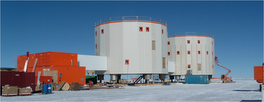Small steps count !
 In two weeks or so, I will he heading off to do some dubious field experiment in seismology, in a less-than-practical field area. And what do I expect we will learn from such an experiment? What will make the deployment a success?
In two weeks or so, I will he heading off to do some dubious field experiment in seismology, in a less-than-practical field area. And what do I expect we will learn from such an experiment? What will make the deployment a success?
You may have read previous posts about the objectives of seismological investigation in Antarctica, which mostly involve improvements in our knowledge of its crustal and lithospheric structure, and in our understanding of the inner core. But before we even get to the analysis part, our first great success would be in obtaining data in the first place.
There is so little data available from Antarctica, that any good quality recordings we can make will be valuable. After that, any inference we can make from that data will be icing on the cake. In any case, East Antarctica will not be "solved" during the International Polar Year. We may hit some of our research targets, we may not, but what is almost certain is that we will dig up more questions.
I read a couple of things last week that brought home to me how science advances only one small step at a time, with many findings only appearing after many years of consistent observation. Unfortunately, what today's society wants - and what funding agencies ask for more and more - are predictable results, within two or three years max. It is also getting harder and harder to publish observations without having to come up with some revolutionary interpretation for them. None of this is doing science itself any good.
There are many voices saying similar things. Here are two recent ones:
The author of the Clastic Detritus blog has just defended his PhD thesis on sedimentary geology. Two days before his thesis defense, he posted a piece on how doing science is being like a cog in a giant wheel.
I think people (some scientists included) need to understand how science progresses — through incremental steps over long periods. Yes, there are certainly big leaps (breakthroughs) that are attributed to individuals or small groups of researchers, but those need to be considered within the context of the incremental progression. [...]
Doing science is being a small cog in a giant wheel. Unfortunately, it seems this view is taken rather negatively nowadays. As if being a part of something bigger takes away from individuality. I think that’s a bogus viewpoint. If what I do ends up getting acknowledged beyond my small specialist clique, that’s great! But, I don’t expect it to. I’m not in science for fortune and glory. Surely, I would enjoy the accolades and try to capitalize on it (i.e., get more funding to do more), but visions (delusions) of grandeur certainly don’t motivate me.
In last week's edition of Nature there is a commentary piece by Euan Nisbet on Earth monitoring as Cinderella science. Although the article is focused on the problem of environmental monitoring, much of it is also relevant to solid Earth monitoring such as is carried out by seismological observatories around the world.
Monitoring is science's Cinderella, unloved and poorly paid. Sustaining a long-term, ground-based program that demands high analytical standards remains challenging. Funding agencies are seduced either by 'pure' notions of basic science as hypothesis-testing, or by the satanic mills of commercial reward. Neither motive fosters 'dull' monitoring because meeting severe analytical demands is not seen as a worthwhile investment. At one stage, Keeling was ordered to guarantee two discoveries per year and today, modern research has become a planned journey through set 'milestones' to deliverable destinations.What should be taken from all this. Only one message: each step counts, and though the big ones may be flashy, it is the small ones that take you where you're going.
Photo credit: photo modified from an image of Júlio Reis.
-----
Keep up to date with the latest developments at http://sismordia.blogspot.com




No comments:
Post a Comment